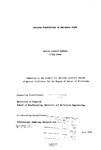PRESSURE FLUCTUATIONS IN TWO-PHASE FLOWS
| dc.contributor.author | Samways, Andrew Leonard | |
| dc.contributor.other | School of Engineering, Computing and Mathematics | en_US |
| dc.date.accessioned | 2011-09-29T12:52:22Z | |
| dc.date.available | 2011-09-29T12:52:22Z | |
| dc.date.issued | 1992 | |
| dc.identifier | Not available | en_US |
| dc.identifier.uri | http://hdl.handle.net/10026.1/791 | |
| dc.description | Merged with duplicate record 10026.1/1680 on 14.03.2017 by CS (TIS) | |
| dc.description.abstract |
Naturally occurring pressure fluctuations have been observed in two-phase flows by a number of researchers for example Matsui [1984]. This thesis Investigates the nature of these pressure fluctuations within vertically upward bubbly two-phase flows with a view to developing a novel non-intrusive pressure correlation technique for use downhole to monitor the area average dispersed phase velocity, Vg. To date non-intrusive correlation flow monitoring techniques suitable for use downhole exhibit a non-uniform field sensitivity characteristic which when correlated between two points reflects the velocity of the dispersed phase within the stronger sensing region. Four sources of pressure fluctuations were Identified In the present study, these being temporal variations in the average gas void fraction a(t), variations in the convected pressure field surrounding a moving bubble, turbulence generated by the wake of a bubble and background turbulence in the continuous phase. Magnitudes and structure length scales of these pressure sources were evaluated differentially at two points in a continuous fluid using simple models and it was found that pressure fluctuations associated with a bubbles motion close to the measurement points dominate the pressure signal. It was also found that the magnitude of pressure fluctuations associated with a bubble's motion decreases rapidly with increasing distance from the bubble and the structure length scale caused by this effect Is of the order of the tapping separation distance. Using numerical simulation techniques and a recirculating air/water flow loop with a test section diameter of 77.8mm, (both of which were developed in this thesis) differential pressure fluctuations generated by an upwardly flowing bubbly two-phase flow w ere studied. Superficial gas and liquid velocities up to 0.35m/s and 1.5m/s respectively and-. average gas void fractions up to 25% were covered. It was concluded -t hat. pressure fluctuations caused by bubble motion near the pipe wall dominate` the, differential pressure signal. The... autocorrelogram of these signals is considered to be related to tie 'bubble velöcity within the'entrapped bubble layer near the pipe wall, which are observed to travel at an almost '.c onstant velocity independent of the continuous phase velocity. Cross correlation of two pressure signals are indicated,,, to be related to the convected bubble velocity of bubbles outside the entrapped bubble layer which is related to Vg. | en_US |
| dc.description.sponsorship | Schlumberger Cambridge Research Ltd | |
| dc.language.iso | en | en_US |
| dc.publisher | University of Plymouth | en_US |
| dc.title | PRESSURE FLUCTUATIONS IN TWO-PHASE FLOWS | en_US |
| dc.type | Thesis | |
| dc.identifier.doi | http://dx.doi.org/10.24382/4297 | |
| dc.identifier.doi | http://dx.doi.org/10.24382/4297 |
Files in this item
This item appears in the following Collection(s)
-
01 Research Theses Main Collection
Research Theses Main


